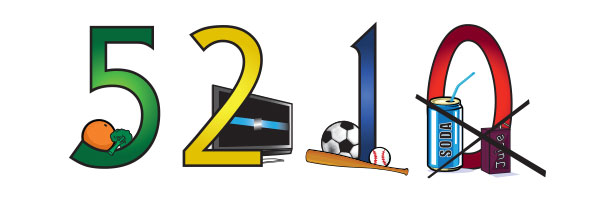The Palo Alto Medical Foundation and El Camino Hospital developed the Youth Nutrition Program, also known as 5-2-1-0, to improve the health of children and their families. The curriculum encourages youth to eat fruits and vegetables, participate in physical activity, reduce screen time and eliminate sugary drinks.
The program began in 2004 as the Palo Alto Medical Foundation’s Youth Nutrition Program, funded by a three-year grant from Applied Materials. In 2010, Palo Alto Medical Foundation and El Camino Hospital redesigned the program as “5-2-1-0: Numbers to Live By.” Today, the program reaches children and their families in elementary and middle schools in Sunnyvale, Campbell, Cupertino and San Jose.
Download the brochure (PDF) English | Spanish
For more information, visit one of our Health Education Resource Centers (HERC) or contact 5210BayArea@sutterhealth.org.

5-2-1-0: Numbers to Live By
- 5: Aim for at least 5 fruits and vegetables every day – A diet rich in fruits and vegetables provides vitamins and minerals important for supporting growth, development and immune function in children. A high daily intake of fruits and vegetables is associated with lower rates of chronic diseases, such as heart disease, stroke, high blood pressure, diabetes and possibly some cancers. Emerging science suggests that eating fruits and vegetables may help prevent weight gain and, when total calories are controlled, may be an important aid to achieving and sustaining weight loss.
- 2: Keep recreational screen time to 2 hours or less every day – Looking at screens occupies many children for several hours each day and is associated with physical inactivity, increased calorie intake (snacking in front of the TV), excess weight and obesity. Too much TV and screen use have been linked to lower reading scores and attention problems. The American Academy of Pediatrics recommends that children under age 2 not use screens at all.
- 1: Include at least 1 hour or more of active play every day – Regular physical activity is essential for fitness and prevention of excess weight and chronic diseases such as heart disease, diabetes, colon cancer and osteoporosis. While most school-age children are quite active, physical activity sharply declines during adolescence. Children who are raised in families with active lifestyles are more likely to stay active as adults than children raised in families with sedentary lifestyles.
- 0: Skip sugar-sweetened beverages and drink more water every day – Sugar-sweetened drink consumption has increased dramatically over the past 20 years. High intake among children is linked to excess weight and obesity, reduced milk consumption and dental cavities.
5 Core Elements
5-2-1-0 elements are based on five core tenets:
- Educate – The program strives to educate students, parents, school staff and community members on the “why, what and how” of healthy eating and active living.
- Engage – Education invites participation by way of experiments, physical activity challenges, role modeling, mentoring, special projects and more. Community engagement includes city, school, healthcare and not-for-profit groups who work within the target community.
- Enable – Within the collaborative framework, we can push for policy and environmental change, locate resources and find funding and partners to work with schools. Parent groups, schools, after-school food service staff, mentoring programs and district leadership support are critical to success.
- Evaluate – All program elements are tested and measured for impact using survey tools, checklists and attendance statistics, visual inventories and verbal feedback.
- Evolve – Sharing best practices, analyses and data, and maintaining ongoing communication with community partners encourages an evolutionary approach. This enables the program to serve a variety of communities.
This program is adapted from MaineHealth Let’s Go!











